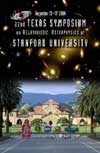Parallel B Talks: Abstracts
View Abstract Summary
0201: X-ray Outbursts from Black-Hole Binaries
Authors: Ronald Remillard (Massachusetts Institute of Technology)
RXTE and other high-energy observatories continue to probe the properties of stellar-size black holes and the physics of accretion using bright X-ray transients in the Galaxy. Progress has been made in recognizing that the three states of active accretion are related to three physical elements that may contribute radiation: the accretion disk, a jet, and a compact (and radio-quiet) corona. Each of these states offers potential applications for strong-gravity predictions of general relativity. High-frequency QPOs are especially interesting in this regard, as the evidence mounts for their interpretation as stationary 'voice-prints' that may constrain black-hole mass and spin.
0202: Intermediate Mass Black Holes?
Authors: Richard Mushotzky (NASA Goddard Space Flight Center)
The possible existence of intermediate mass black holes has been suggested as the origin of the ultra-luminous x-ray sources in nearby galaxies. I will examine the evidence for and against the existence of such objects concentrating on x-ray time series, x-ray spectra, the nature of the optical counterparts and the environment of the object.
0203: General Relativistic MHD Simulations of Black Hole Accretion Disks
Authors: John Hawley (University of Virginia)
Observations are providing increasingly detailed quantitative information about the accretion flows that power such high energy systems as X-ray binaries and Active Galactic Nuclei. These observations have been modeled in some detail by a variety of accretion scenarios, but such models rely on unavoidable assumptions such as regular flow geometry and a simple, parameterized stress. Global numerical simulations offer a way to investigate the basic physical dynamics of accretion flows without these assumptions. We have developed a fully three-dimensional general relativistic magnetohydrodynamic simulation code that evolves time-dependent inflows into Kerr black holes. The results from recent global simulations of black hole accretion disks will be reviewed, with an emphasis on the influence of the rotating hole on the disk and on jet production.
0204: Primordial Black Holes
Authors: Bernard Carr, Astronomy Unit, Queen Mary, University of London
Recent developments in the study of primordial black holes (PBHs) will be reviewed, with particular emphasis on their formation and evaporation. PBHs could provide a unique probe of the early Universe, gravitational collapse, high energy physics and quantum gravity. Indeed their study may place interesting constraints on the physics relevant to these areas even if they never formed. In the "early Universe" context, particularly useful constraints can be placed on inflationary scenarios or on quintessence models, especially if evaporating PBHs leave stable Planck-mass relicts. In the "gravitational collapse" context, the existence of PBHs could provide a unique test of the sort of critical phenomena discovered in recent numerical calculations. In the "high energy physics" context, information may come from gamma-ray bursts (if a subset of these are generated by PBH explosions) or from cosmic rays (if some of these derive from evaporating PBHs). In the "quantum gravity" context, the formation and evaporation of small black holes could lead to observable signatures in cosmic ray events and accelerator experiments, providing there are extra dimensions and providing the quantum gravity scale is around a TeV rather than the Planck scale.
0205: Dark Energy Stars
Authors: George F. Chapline (Lawrence Livermore National Laboratory)
Event horizons and closed time-like curves cannot exist in the real world for the simple reason that they are inconsistent with quantum mechanics. Following ideas originated by Robert Laughlin, Pawel Mazur, Emil Mottola, David Santiago and the speaker it is now possible to describe in some detail what happens physically when one approaches and crosses a region of space-time where classical general relativity predicts that there should be an infinite red-shift surface. This critical surface physics provides a new perspective on a variety of enigmatic astrophysical phenomena including supernovae explosions, gamma ray bursts, positron emission, collimated jets, and dark matter.
0206: The Anthropic Landscape of String Theory
Authors: Leonard Susskind (Stanford)
I will review the recent developments in string theory that suggest the existence of a huge Landscape of vacua and also the implications for cosmology and particle physics.


